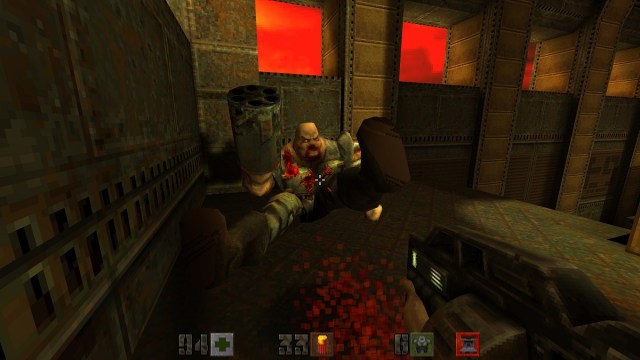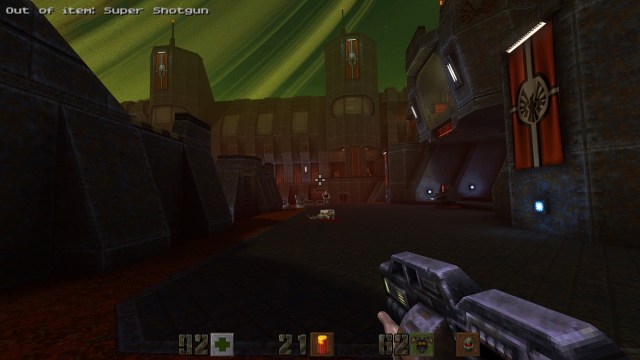I’ve never really gotten elbow-deep into the Quake series. Before the 2021 Quake remaster by Nightdive Studios, I was actually most familiar with Quake 4, and I really don’t remember that much about it. In 1996, I was into Duke Nukem 3D. And then after that, it was Goldeneye 007. I at least played Quake 2… The N64 version.
But after the first Quake was remastered and introduced me to the series, I held off on any more series exploration, anticipating the second one would eventually get the same treatment. My patience paid off, and the Quake II remaster has arrived. Once again, it’s a terrific introduction.

Quake 2 (PC [Reviewed], PS4, PS5, Xbox One, Xbox Series X|S, Switch)
Developer: id Software, NightDive Studios, MachineGames
Publisher: Bethesda Softworks
Released: August 10, 2023
MSRP: $9.99
After the development of the first game in the Quake series was beset by creative differences, many members of id Software departed, including Sandy Peterson and John Romero. This is considered by many to be the end of classic id Software, as it seemed like the heart had left the brain with an empty bed.
You can sort of feel that in Quake II. There was something of an anarchic directionlessness in Quake that is replaced with something a lot more cohesive. Quake still felt like a first-generation shooter like Doom. Quake 2 is a lot closer to Half-Life.
You can see this clearly in the narrative. Earth has been under attack by the Strogg and hasn’t been faring well. So, the meaty humans launch a counter-attack, taking the fight to the meat substitute Strogg’s homeworld of Stroggos. Quake II and all the expansions are set around this counter-attack as you take control of different space marines attempting to hinder the enemy’s ability to wage war on humanity.
The first Quake really didn’t have much of a narrative, and this is definitely not a continuation. This comes with its pros and cons. The biggest positive is that a more defined narrative gives you purpose that helps drive you through the game. The downside is that the Strogg don’t care much for interior design, and there’s little visual diversity throughout the campaigns.
Out of item
Nightdive’s remaster is similar to their approaches to the original Quake and the recent Rise of the Triad: Ludicrous Edition. They have gathered all the expansions into one package, added a newly created campaign, and transported everything to their more modern KEX Engine, bringing with it a number of extra visual and gameplay options. And then, after already doing more than most would expect, they continue on to polish up the graphics and gameplay without tampering with the overall feeling and aesthetic of the title.
It’s extensive. They even upscaled the cinematics. Then, somehow, they ported all of the N64 version of Quake II’s levels. For whatever reason, when Raster Productions handled the N64 port, they wound up remaking almost all of the levels. It’s just as much its own campaign as the other expansions. It seems like it would be quite an effort to re-port the N64 version back to PC, but it was very worth it. It contains visual flourishes that make it, at the very least, aesthetically worth exploring.
The two expansions by Xatrix Entertainment and Rogue Entertainment are necessary inclusions, even if they mostly just feel like added content. Which, to be fair, is essentially what they were when they first released.
Meanwhile, the new campaign, Call of the Machine, by MachineGames is a great way of showing off the many successes of Quake 2 while minimizing its deficiencies. Visual variety is a lot better here, depicting a lot of different and interesting locales based on the Strogg War story but in places not shown in the games. It’s an effective way to demonstrate the outstanding gunplay, fast action, and interesting enemies without eliminating the unique flavor of the base game.

Someone hang a poster
Which to be fair, as much as I hassle Quake 2 for its repetitive brown corridors, I do enjoy it. The main campaign is maybe a 6-8 hour romp. It kept my attention through to the end, even when similar games with shinier corridors failed to. Games like Dusk have demonstrated the lasting appeal of the clunkier and more straightforward games of yesteryear, and Quake 2 is an essential example of that.
But beyond that, Nightdive’s remaster makes things a little more pleasant. One great feature is the compass, which draws a path to your next objective. It’s not that Quake 2 was obtuse beyond reason. Each of the “units” of the game is composed of a handful of small levels, so you’re destined to trip over what you’re looking for. It’s just a matter of how much backtracking you’ll have to endure.
For example, you might finish a secondary objective and see the message “turbine disabled.” Perhaps you won’t realize it’s talking about the fan that you just passed and can now bypass. So, you continue on your merry way, and then when you finally circle back, you say, “Ooooh. It was talking about this turbine.”
So, I mostly used the compass whenever I came back to a familiar-looking room and wanted to make sure I wasn’t just going in circles.

That’s a lot of screens
As usual for Nightdive remasters, their all-encompassing approach to Quake II makes it the definitive way to play the game. Beyond just compiling all the expansions, certain features, such as AI, were buffed up, and cut content was restored. And then there’s also the multiplayer, which in some versions supports 8-player split-screen local. Or you can play online, if you don’t like sharing your screen.
But if, for whatever reason, none of that sounds good to you, the original versions are still available.
For me, it was a great introduction to Quake II. The PC version, I mean. It’s an oppressively brown shooter, but it still carries the speedy, lightweight combat that makes older FPS games still pop today. The changes that Nightdive brought in for the remaster make it even more enjoyable and accessible. It may not have the same experimental charm as Rise of the Triad: Ludicrous Edition, but it more than makes up for it with its tight and gory gunfights.
[This review is based on a retail build of the game purchased by the reviewer.]














Published: Aug 14, 2023 03:00 pm